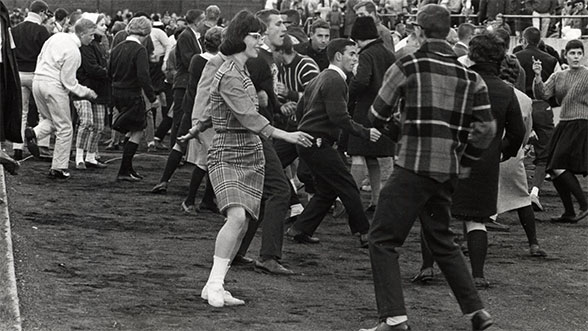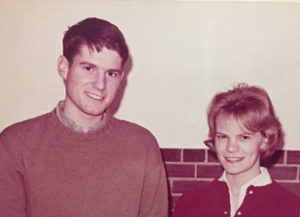“Do you know how to Twist?”
Janie Schember and Eric Hall met on the first day of freshman orientation, September 1961. There was a big mixer at the Union, and there was a guy there Janie knew from high school named Ron. He came up and said: “Janie, I met a guy I think you’re gonna like.”
“Geez, Ron,” she said, “already you’re trying to fix me up?”
But she said OK, and right away she liked him — a tall, good-looking guy from Long Island (“gorgeous” is the word she uses now), upbeat, fun, not afraid to talk.
Over on the other side of the dance floor, they watched some kids doing a dance Janie had never seen before.
“Do you know how to twist?” Eric asked her.
“No,” she said. “What’s that?”
Chubby Checker’s hit single had topped the charts a year earlier, but Janie came from a small town, Grand Haven, Mich., and she’d sort of missed it.
“Well, you do this,” Eric said. He took her hands. “You pivot on your feet like this.”
It took her about 30 seconds to catch on.
“She could dance. . .”
 Eric was twisting, too, but mostly he was watching Janie. He didn’t know she’d been dancing since she was a little kid. And he couldn’t believe how good she was.
Eric was twisting, too, but mostly he was watching Janie. He didn’t know she’d been dancing since she was a little kid. And he couldn’t believe how good she was.
Even now, after almost 60 years, he still can’t believe how good she was.
“She could dance, OK?”
Sure, he says now, the Twist was pretty easy to do. But then, with a faraway note that hinted at a clear mental movie of Janie Schember twisting in the fall of 1961, he says: “. . . but not to do well.”
Eric lived at West Quad, Janie at Alice Lloyd. All that fall, they saw a lot of each other. They took long walks and went to football games. When the weather turned chilly, they retreated inside to study at the library or drink hot chocolate at Drake’s. And, of course, they danced the Twist.
When they returned from the Christmas break, they met up for a dance party in East Lansing on New Year’s Eve. They got back to Ann Arbor and started to study for finals. Then, on Saturday, Jan. 6, 1962, Eric spotted a notice in the Daily:
“UNION TO SPONSOR TWIST COMPETITION”
The contest would happen that night at the Union-sponsored Sock Hop, nine to midnight in the Union Ballroom. The band would be the Classmen. Cost per couple: $1.
They just had to enter.
“Come on, baby…”
As early as 1912, African-Americans were doing a risque step called the Mess Around that looked a lot like the Twist. Other dances mimicked the Mess Around’s moves, including Ballin’ the Jack and the Black Bottom. In R&B lyrics, “twist” often served as a euphemism for sex.
By the mid-‘ 50s, lyrics about twisting were passing from one R&B group to another, evolving as they went. In 1957 a version landed with a Detroit R&B man named Hank Ballard, who changed the opening line to a dance invitation (“Come on, baby, let’s do the Twist”), added the classic “You should see my little sis . . .” (borrowed from a Jelly Roll Morton lyric) and recorded it in 1958 with his group, the Midnighters, which had a reputation for raunchiness. In 1959, the song climbed to No. 16 on Billboard’s R&B chart, then slipped off.
But Ballard’s version had caught on with black teenagers in the South and Baltimore. On dance floors, they improvised some erotic new moves. Pretty soon those moves showed up in the Philadelphia studio of Dick Clark’s nationally syndicated “American Bandstand.”
“Too black”
Clark had long perfected the art of converting authentic black R&B into teen-idol fare for white teenagers. He knew a hit when he heard one. But Hank Ballard, he confided to associates, was “too black.”
So Clark matched “The Twist” with a baby-faced, light-skinned teenager named Ernest Evans. Inspired by Fats Domino’s name and fame, Evans had taken the stage name Chubby Checker. With a studio band, he recorded a note-for-note imitation of Ballard and the Midnighters. On Aug. 6, 1960, Clark introduced Checker on his weekend show, “The Dick Clark Show,” performing his mild, approved-for-white-teenagers hip-swivel while lip-synching his new version of “The Twist.”
To white audiences, even Chubby’s tame version “was as shocking as the first bikini,” Checker said later. The song pushed Elvis’s “It’s Now Or Never” out of Billboard’s No. 1 slot and went gold in a month.
For a while, the song was a standard rise-and-fall pop hit. It was the dance, not the song, that took off — a just-short-of-naughty routine that caught on with trendy adult Manhattanites at a Mafia-run rock-and-roll dive called the Peppermint Lounge.
From there, it exploded into nationwide pop-culture superstardom. From country-club dance floors to backyard barbecues, adults who wanted to look cool could not stop themselves. Gloria Vanderbilt twisted. Astronauts twisted in zero gravity. Even Jackie Kennedy twisted at the White House.
The contest
Eric Hall had learned the Twist from his older brother, Ned, who brought it back from Princeton in the summer of ’61. But when Eric invited Janie to twist that September, it was a brand new thing in Ann Arbor.
Michigan’s first Twist contest was held outdoors on the Slab (between Haven and Alumni Halls) on Homecoming weekend. The Roadrunners played “Let’s Twist Again” at the pep rally the night before the Purdue game, and obliging members of the varsity twisted for the crowd. At fraternity parties and sock hops, dance music that fall was twist music. So Eric and Janie got plenty of practice.For Christmas, Janie knitted his-and-hers sweaters of teal and white wool — too hot for dancing, really, but they figured matching sweaters would attract the judges’ notice. So that’s what the couple wore to the Union on the night of the Sock Hop.
When the Classmen started to play and the contest began, Eric and Janie took the floor with some 200 other couples. They got hot fast.
The crowd gave a lot of attention to an outrageous duo who had entered as “Mike” and “Molly.” Molly was a tall, gaunt male in a plaid skirt and a mop-haired wig, and some of his moves were downright acrobatic.
But pretty soon the judges were focused on Eric and Janie. One couple after another was told to sit down.
Spins and turns and leg-lifts
 “It was out-of-the-box moves — spins and turns and leg-lifts,” Janie remembers. “I would follow Eric and then do one step further. We’d have one foot on the ground and we’d be twisting with that one leg, while the other one is up and twisting in the air. Not everybody did that. And leaning backwards and way down low on the ground. We didn’t just stand there in space and just twist around. We were all over the map.”
“It was out-of-the-box moves — spins and turns and leg-lifts,” Janie remembers. “I would follow Eric and then do one step further. We’d have one foot on the ground and we’d be twisting with that one leg, while the other one is up and twisting in the air. Not everybody did that. And leaning backwards and way down low on the ground. We didn’t just stand there in space and just twist around. We were all over the map.”
And then they were the only ones left.
Todd Fay, executive vice-president of the Union, declared them the winners and presented their award — the new LP, “Twist With Bobby Darin.”
They were campus king and queen of the Twist.
As good Wolverines, Janie and Eric hadn’t forgotten the 28-0 stomping Michigan had endured at the hands of MSU back in October. One of the state’s stars was the All Big Ten fullback George Saimes. Anything Saimes said was making the papers that year, and he’d been bragging that nobody could outdo him at the Twist.
Eric and Janie begged to differ.
Save the last dance

View the whole page via the Daily’s digital archive.
Alas, no fairy-tale ending here. Eric and Janie broke up second semester.
Janie went on to teach science and phys ed, raise three sons, coach cheerleading and drama, work as a fashion consultant, and serve as a longtime city councilwoman in her adopted state of Florida.
Eric and his brother Ben went into manufacturing premium parts for America’s Cup-class sailboats.
But Janie and Eric have been friends ever since that first day freshman year, and they never forgot that night in 1962.
Thirty years after the Twist contest, Eric sent Janie a poster with a blown-up image of the Daily’s story about their victory.
Sources included interviews with Janie Schember Robertson and Eric Hall; “Twinkle-Toed, Torrid Twisters Try to Triumph,” Michigan Daily, 1/7/1962; Richard Bak, “Did You Know ‘The Twist’ Originated in Detroit?” Hour Detroit, 2/21/2013; and Jim Dawson, The Twist: The Story of the Song and Dance that Changed the World (2012).






Vernon Polidoro - 1967
‘Premium parts …for sailboats’…must be the Hall Spars company (?). I have a Hall mast and boom on my J 105 sailboat. When I started at M in the Fall of 1962, the other dance my first date and I did there was the Loco-motion!
Reply
James Tobin - 1978, 1986
That’s right, Vernon — Hall Spars it is!
Reply
Virgil Banowetz - 1963 andd 1967
Who is tracking where and when Twist dance contents are happening today? I want to compete.
Reply